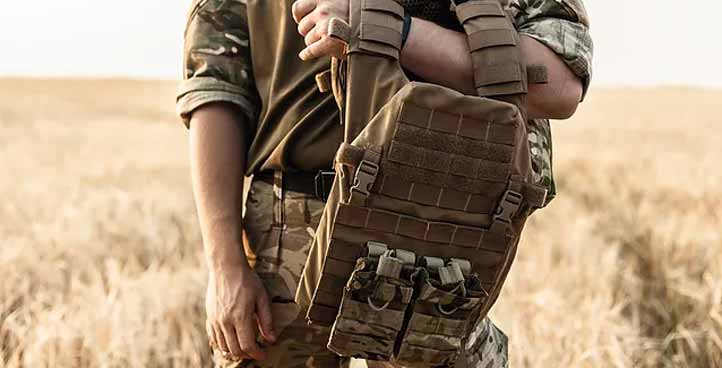Nowadays, science and technology are advancing rapidly, but in terms of the performance of the body armor, it is not able to withstand all damage, but only plays a basic protective role, so it is also a basic but indispensable equipment. Body armor is definitely not able to block all bullets. It is not impossible to make a body armor that can block all bullets, but the body armor made in this way will definitely affect flexibility for wearers.
Body Armor Construction
How Does Ballistic-Resistant Body Armor Work?
When a handgun bullet strikes body armor, it is caught in a “web” of very strong fibers. These fibers absorb and disperse the impact energy that is transmitted to the vest from the bullet, causing the bullet to deform, or “mushroom.” Additional energy is absorbed by each successive layer of material in the vest, until such time as the bullet has been stopped.
Because the fibers work together both in the individual layer and with other layers of material in the vest, a large area of the garment becomes involved in preventing the bullet from penetrating. This also helps in dissipating the forces that can cause nonpenetrating injuries (what is commonly referred to as “blunt trauma”) to internal organs. Unfortunately, at this time no material exists that would allow a vest to be constructed from a single ply of material.
Today’s generation of concealable body armor can provide varying levels of protection to defeat most common low- and medium-energy handgun rounds. Body armor designed to defeat rifle fire is of either semirigid or rigid construction, typically incorporating hard materials such as ceramics and metals. Because of its weight and bulkiness, it is impractical for routine use by uniformed patrol officers and is reserved for use in tactical situations, where it is worn externally for short periods of time when confronted with higher level threats.
How Does Stab-Resistant Body Armor Work?
Stab-resistant body armor works by many of the same principles as ballistic-resistant body armor. Stab- and puncture-resistant armors are made from a variety of materials. The most common designs use multiple layers of materials. These layers are made from extremely strong fibers that can be either woven or laminated together. Other materials used are metals and composites. As the threat impacts the armor, the materials either deflect the threat, or due to their very high levels of tensile strength and cut and/or tear resistance, they slightly “stretch” before breaking or being cut. This “stretching” spreads the impact forces over a larger area of the armor and dissipates the strike energy from the threat, eventually stopping the threat. Most often, multiple layers of materials are needed to successfully stop typical threats. Some of the top layers of material may be defeated, but if properly designed, the armor will stop the threat with little to no penetration. The backing layers provide additional strength to the armor, and
each layer assists in dissipating the strike energy.
Many of the same materials are used in both ballistic-resistant armor and stab-resistant armor, with one important distinction. Because knives, picks, and spikes are pointed, the initial contact forces for stabs threats are very high. These high forces pose a risk to ballistic-resistant armor.
To counter this, stab-resistant armors are normally made from very tightly woven fabrics or from very closely spaced laminated layers.
Protecting Critical Body Parts
On the battlefield or in the mission, the deadly places are the head, neck and other parts. If the limbs are accidentally shot, they will not die immediately. If they are treated in time, they can be rescued. Because the limbs are not deadly parts, the body armor without limbs improve the flexibility and convenience of wearing. After all, the material of the body armor itself is also relatively hard. If the limbs are made, it will affect the flexibility and cause inconvenience in the operation. Body armor can block some bullets. It is naturally very hard and thick. The limbs and joints need to be bent. If the body armor is wrapped, it will definitely affect the posture and actions such as holding a gun, so it will not make limbs protection.
Today bulletproof technology is still developing. I think that with the continuous development of the technology, better and better bulletproof equipment and defensive gears will definitely be continuously developed and produced, step by step to enhance the survival ability of soldiers on the battlefield. So maybe in the future, a body armor that includes limbs protection can be made, and it won’t affect the convenience and flexibility of wearing.








Leave a Reply